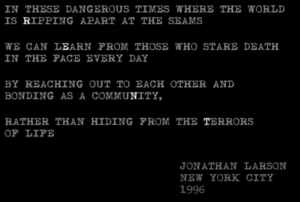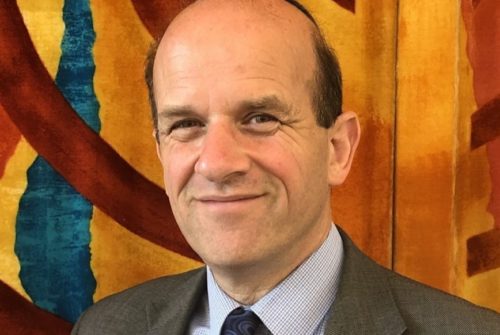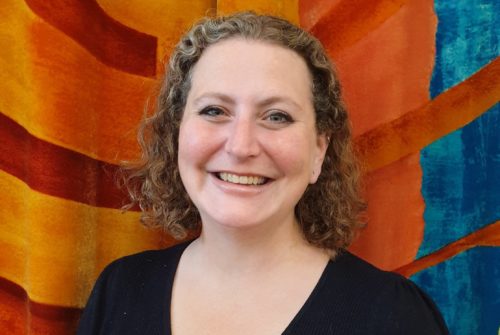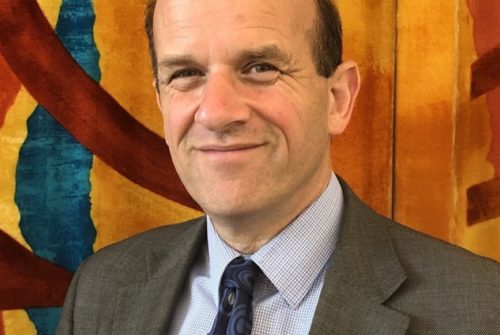Covid memorial Shabbat
[singing]
Five hundred, twenty five thousand, six hundred minutes
Five hundred, twenty five thousand moments so dear
Five hundred, twenty five thousand, six hundred minutes
How do you measure, measure a year?
In daylights, in sunsets
In midnights, in cups of coffee
In inches, in miles
In laughter, in strife
In five hundred, twenty five thousand, six hundred minutes
How do you measure a year in a life?[1]
For those of you who aren’t musical fans, that was the opening verses of ‘Seasons of love’ from Jonathan Larson’s Musical ‘Rent’, first performed in 1994. In Rent, a group of New Yorkers struggle with their careers, love lives and the effects of AIDS on their community. We have now lived for 2 years with the Covid pandemic – two times five hundred, twenty five thousand six hundred minutes. Measured in sourdough, in memes, in zoom meetings. Measured in funerals, loneliness, and working parents forced to home-school.
On Thursday night we held a panel which included our incredible member Dr Jackie McRae who last year won a Giving Voice award for her work promoting speech and language therapy for Covid-19 patients, following her work at NHS Nightingale. She shared photos of her face, scarred by hours wearing PPE, and I was reminded of the incredible debt we all owe to so many. I won’t lie, seeing Jackie’s photos somehow took me right back to those early, dark dark days of the pandemic, and I was quite choked up seeing them. Jackie also remembered that this time 2 years ago, as the NHS was mobilising the Nightingale hospitals, our healthcare providers really had no idea what they were dealing with, or how to treat it. And at EHRS we know the impact of that only too well.
As rabbis, we were able to leave the house slightly more often than most, but we really wished not to. Our trips were to our cemetaries and crematoria, where the staff and burial societies were working the longest hours they have ever known. We stood alone, joining mourners over zoom, losing the ability to hold those mourners, unable to visit. We did our best, but often it couldn’t be enough.
Over the last two years I have heard the measure of too many lives shared with me; memories of lives walked together, some for not long enough. Through the pandemic I also heard new stories emerging from the Torah. A commentary on the book of Numbers[2], from where our second Torah reading came today, teaches us that the Torah has 70 faces. This is a phrase we rabbis use a lot, but the Pandemic really brought it to life for me – in every generation we turn the text and find it speaks to us in new ways because we are different and the world if different. Our extra reading today, the Red Heffer, is one such piece that suddenly seemed to have a new face during the pandemic.
The Parah Adumah – or Red Heffer is a law that is called a ‘chok’ – a law whose purpose cannot be understood. (That also rings some bells for times over the last two years when rules and laws have changed so rapidly and sometimes so opaquely we struggled to keep up!) In this particular case, it is a ritual which requires us to find a perfectly red cow – with not even one single hair a different colour, and no blemish of any other kind. Once such a rare treasure is found, a Priest performs a sacrifice, ritually sprinkling its blood, and then burns the heffer in it’s entirety along with fragrant herbs, thread and woods. The ashes are then stored carefully to ensure they stay ritually pure. These precious and hard to produce ashes would then be used to cleanse members of the tribe who had come into contact with a dead body – which carried ritual impurity.
This language of pure and impure is often alienating, especially to modern readers. But it doesn’t imply dirt or filth. It was a status men and women would all move in and out of, and which decided to what extent they could participate in Temple Rituals. In short hand, if you were yourself sick, or might have been in contact with someone sick, or indeed someone who had died and would therefore also be a source of sickness, measures were put in place to quarantine you from mixing with the majority of the community. You had to wash carefully before returning to the community. Reading the ritual of the Red Heffer during Covid, as well as the rites of sacrifice and purification that exist in our torah portion this week, serves as a helpful reminder that our Biblical ancestors understood Public Health. Not quite as we did, but the difficulty of finding a Red Heffer was a reminder to the Israelites to avoid physical contact with the dead, because, I would argue, this was the best way to prevent more people succumbing to illness. Purity and Impurity in Torah was Biblical Public Health care, and the story goes that in fact Jewish ritual washing has played its role throughout history in helping to protect the community from the worst ravages of plagues like the Black Death.
While Biblical public health included social distancing and washing and quarantining, as did the advice to us all 2 years ago, any historic protection we may have enjoyed in previous plagues was gone. Here at EHRS we know only too well just how awful and tragic those first months of the pandemic and lock down were. When I started my first meeting on my first day at EHRS on April 21 2020, the first thing I was asked to do was a funeral. There had already been 20 in EHRS that month.
As Rabbi Charles Middleburgh said at our panel on Thursday night, however wonderful our education at Leo Baeck College had been, nothing could have prepared us for the closing down of our synagogue buildings, the removal of so much of our mourning ritual, our human contact, and the grief and stress surrounding all of us. So many here today mourned alone, so different to how we normally cope with these things. And our hearts broke with you.
For sure, we did not get everything right. But while I found new faces to the Torah during the pandemic, I also found ways we could connect as a community that I never would have imagined. We saw the most incredible local initiatives, charitable organising, including You donate We deliver from EHRS members wanting to support and feed NHS staff. Our own community circles did their best to reach out to as many as possible in the community, and volunteers like then Senior warden Annita and Tony O’Brart did all they could to keep phoning members whether for yahrzeit or birthdays.
The singers of Rent ask ‘How do you measure a year’ and one of their answers, asks us to measure it in love. We have all known immense grief and loss over the last two years. But I hope you have also experienced immense love.
Jonathan Larson, the writer of Rent, said:

These words are not recent words. They were offered in 1996, as communities faced the horrors of the AIDS pandemic, an illness that remained a death sentence until relatively recently. Humanity faces plagues and challenges in every generation. The medicine changes, the science grows, but measuring life in love remains the same. Community remains the place where support and solace are at our core. If we have failed in offering it, we can only ask forgiveness. But I know for me, the last two years would have been even darker were it not for all of you, who welcomed me at our darkest hour, and allowed me to be with you in your grief, and in your joy.
Five hundred, twenty five thousand, six hundred minutes
Five hundred, twenty five thousand moments so dear
Five hundred, twenty five thousand, six hundred minutes
How do you measure, measure a year?
In daylights, in sunsets
In midnights, in cups of coffee
In inches, in miles
In laughter, in strife
In five hundred, twenty five thousand, six hundred minutes
How do you measure a year in a life?
How about love?
How about love?
How about love?
Measuring love
Seasons of love
[1] https://www.youtube.com/watch?v=Zp5Eyt7knus
[2] Bemidbar Rabbah 13:16



